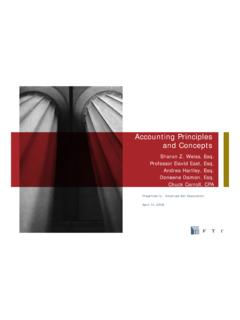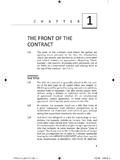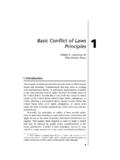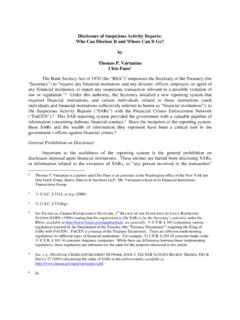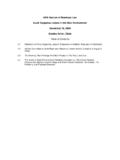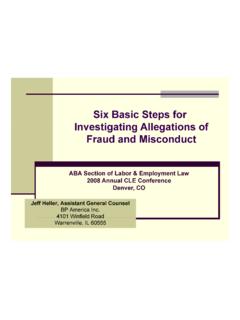Transcription of Lender Liability Considerations - American Bar …
1 Lender Liability Considerations Lender Liability is the result of a Lender s conduct; it is not an activity. Generally, Lender Liability arises from either a breach of a common law (or judicially created) obligation or a violation, whether intentional or inadvertent, or a breach of a federal or state statutory obligation. Thus, Liability has been found where a Lender exercises excessive control over a borrower s affairs, engages in inequitable or fraudulent conduct with respect to the borrower or other creditors of the borrower, or engages in conduct proscribed by applicable federal or state laws. In these circumstances, the Lender may be held liable to the borrower or third parties for damages or penalties, may find its claims equitably subordinated to claims of others, or may have its claims avoided entirely.
2 The imposition of a common-law duty of a Lender to a borrower or a third party derives primarily from the Lender s exercise of control over the borrower. Although the leverage that lenders often have in negotiating loan documents, particularly in a default/restructuring scenario, and the loan documents themselves ( , contractual provisions that restrict the borrower s activities or require the borrower to take certain actions in the event of default) arguably could constitute a starting point for purposes of establishing Lender Liability , the leverage itself does not equal Indeed, the trend in courts has been to exonerate a Lender that has acted strictly within the terms of its agreement with the borrower as long as its actions have been reasonable.
3 The actions of the Lender with respect to an agreement s provisions and remedies, not their mere existence, may be the basis for a court s finding of Liability . Thus, advice to lenders and borrowers depends on an analysis of the facts and circumstances of the individual case and frequently requires difficult judgments in balancing the Lender s interest in maximizing its recovery against the risks inherent in the Lender s assertion of its contractual rights. In addition to a common-law duty, the Lender , through the activities of the borrower, is subject to provisions of tax laws, federal and state securities laws, the Fair Labor Standards Act2 (FLSA), and the Racketeer Influenced and Corrupt Organization Act3 (RICO), among others.
4 Failure to comply with these statutory requirements may subject the Lender to civil fines or penalties. 1 Cosoff v. Rodman (In re Grant Co.), 699 599, 609 (2d Cir.), cert. denied, 464 822 (1983). 2 29 201-219 (1994). 3 18 1961-1968. Lender -BORROWER RELATIONSHIP The mere existence of a Lender -borrower relationship does not impose fiduciary obligations on the Ordinarily, the relationship between a bank and its customer is one of debtor and creditor .. [a]nd the duty owed for simple negligence is one of ordinary care. 5 Indeed, except in special circumstances, a bank does not have a fiduciary relationship with its borrowers.
5 6 If, however, there is a confidential relationship between a bank and its customer, a fiduciary obligation might be imposed on the bank. 7 Such a duty is implied by law and its existence, imposition and breach depends upon specific factual A confidential relationship is created when trust is reposed by one party in another with resulting superiority and influence exercised by the The existence of a confidential relationship alone, however, is not sufficient to impose Liability on a Lender for breach of fiduciary duty. For instance, to establish Liability , some courts have required that the borrower also demonstrate that the Lender inequitably abused that confidence by wrongfully using its position of superiority in order to obtain an unconscionable advantage over the other For example, in Hoffman v.
6 Lincoln National Bank & Trust Co.,11 the individual plaintiffs cited the following, among other things, as evidence of a confidential relationship: 4 See, , Sallee v. Fort Knox Nat l Bank, (In re Sallee), 286 878, 893 (6th Cir. 2002); Forsythe v. BancBoston Mortgage Corp., 135 1069, 1077 (6th Cir. 1997); Grant, 699 at 609; Paradise Hotel Corp. v. Bank of Nova Scotia, 842 47, 53 (3d Cir. 1988); Aaron Ferer & Sons Ltd. v. Chase Manhattan Bank, , 731 112, 122 (2d Cir. 1984); Knapp v. Am. Gen. Fin., Inc., 111 F. Supp. 2d 758, 766 ( Va. 2000); Globe Motor Car Co. v. First Fidelity Bank, , 641 1136 1138-39 ( Super.)
7 Ct. 1993), aff d, 677 794 ( Super. Ct. App. Div. 1996). 5 Mans v. Peoples Bank, 10 885, 889 (Ark. 2000); see also General Motors Acceptance Corp. v. Baymon, 732 262, 270 (Miss. 1999) ( the general rule is that there is no presumption of a fiduciary relationship between a debtor and creditor ) (internal quotations and citations omitted). 6 See, , Sallee, 286 at 893. 7 Hoffman v. Lincoln Nat l Bank & Trust Co., 636 185, 188 (Ind. Ct. App. 1994); see also Bear Stearns & Co. v. Daisy Sys. Corp. (In re Daisy Sys. Corp.), 97 1171, 1177-78 (9th Cir. 1996) (finding confidential relationship to be necessary to determine whether a bank owes a fiduciary duty).
8 8 See, , Susan Fixel, Inc. v. Rosenthal & Rosenthal, Inc., 842 So. 2d 204, 207-08 (Fla. Dist. Ct. App. 2003); Stokes v. Henson, 217 Cal. App. 3d 187, 194 (1990). Some courts have presumed a confidential relationship if there is an agency relationship between the parties. See, , Daisy Sys. Corp., 97 at 1178. 9 See, , Sallee, 286 at 892-93; Amendola v. Bayer, 907 760, 763 (7th Cir. 1990); In re Handy & Harman Ref. Group, Inc., 293 299, (Bankr. D. Conn. 2003). 10 Hoffman, 636 at 188. But see Groob v. KeyBank, 843 1170 (Ohio 2006) (prospective Lender not liable for breach of fiduciary duty when loan agent used confidential information for her own benefit).
9 11 636 185. the plaintiffs were unsophisticated in financial matters; all their banking had been with the defendant and they had turned to the bank for most of their financial needs and advice; they had relied on the bank for guidance in financing the project which was the basis of the suit; the bank had encouraged them to begin construction of the project before the loan closed; and the bank knew prior to making the loan that the plaintiffs business was undercapitalized. Even if, however, the actions of the Lender in Hoffman did create a confidential relationship, the court held that the plaintiffs had failed to demonstrate that the bank gained an unconscionable advantage by abusing it.
10 As Hoffman noted, the bank itself had lost more than $70,000 on the transaction at issue. Other courts may use different language to describe the existence of a fiduciary relationship, but apply a test similar to the confidential relationship/ unconscionable advantage standard employed in Hoffman. For example, in Capital Bank v. MVB, Inc., the court held that it would recognize a fiduciary relationship between a bank and a customer where the bank knows or has reason to know of the customer s trust and confidence under the circumstances exceeding an ordinary commercial transaction. 12 In this case, a bank s loan officer expressly invited the borrower s reliance and trust in the bank and the bank was aware of such reliance, which established a confidential relationship between the bank and the borrower.

